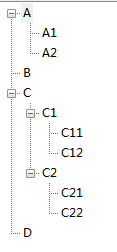[datagridview与treeview绑定]
treeview
代码:
DataTable dtable = new DataTable("Rock"); //添加8列 dtable.Columns.Add("1", typeof(System.String)); dtable.Columns.Add("2", typeof(System.String)); dtable.Columns.Add("3", typeof(System.String)); dtable.Columns.Add("4", typeof(System.String)); dtable.Columns.Add("5", typeof(System.String)); dtable.Columns.Add("6", typeof(System.String)); dtable.Columns.Add("7", typeof(System.String)); dtable.Columns.Add("8", typeof(System.String)); //添加一行数据 DataRow drow = dtable.NewRow(); drow["1"] = "11"; drow["2"] = "22"; drow["3"] = "33"; drow["4"] = "44"; drow["5"] = "55"; drow["6"] = "66"; drow["7"] = "77"; drow["8"] = "88"; dtable.Rows.Add(drow); //绑定数据 multiColHeaderDgv2.DataSource = dtable;
datagridview多维表头实现效果:
自定义控件全部代码:
using System; using System.Collections.Generic; using System.Text; using System.Windows.Forms; using System.Drawing; using System.ComponentModel; namespace myMultiColHeaderDgv { public class MultiColHeaderDgv:DataGridView { #region 字段定義 ///多維列標題的樹結構 /// /// private TreeView _ColHeaderTreeView; /// 樹的最大層數 /// /// private int iNodeLevels; /// 一維列標題的高度 /// /// private int iCellHeight; /// 所有葉節點 /// /// private IList ColLists = new List (); #endregion #region 屬性定義 /// 多維列標題的樹結構 /// /// [ Description("多維列標題的樹結構") ] public TreeView myColHeaderTreeView { get { return _ColHeaderTreeView; } set { _ColHeaderTreeView = value; } } #endregion #region 方法函數 /// 遞歸計算樹最大層數,並保存所有葉節點 /// /// /// /// private int myGetNodeLevels(TreeNodeCollection tnc) { if (tnc == null) return 0; foreach (TreeNode tn in tnc) { if ((tn.Level + 1) > iNodeLevels)//tn.Level是從0開始的 { iNodeLevels = tn.Level+1; } if (tn.Nodes.Count > 0) { myGetNodeLevels(tn.Nodes); } else { ColLists.Add(tn);//葉節點 } } return iNodeLevels; } /// 調用遞歸求最大層數、列頭總高 /// /// public void myNodeLevels() { iNodeLevels = 1;//初始為1 ColLists.Clear(); int iNodeDeep = myGetNodeLevels(_ColHeaderTreeView.Nodes); iCellHeight = this.ColumnHeadersHeight; this.ColumnHeadersHeight = this.ColumnHeadersHeight * iNodeDeep;//列頭總高=一維列高*層數 } /// 获得合并标题字段的宽度 /// /// /// 字段节点 /// 字段宽度 private int GetUnitHeaderWidth(TreeNode node) { int uhWidth = 0; //获得最底层字段的宽度 if (node.Nodes == null) return this.Columns[GetColumnListNodeIndex(node)].Width; if (node.Nodes.Count == 0) return this.Columns[GetColumnListNodeIndex(node)].Width; //获得非最底层字段的宽度 for (int i = 0; i <= node.Nodes.Count - 1; i++) { uhWidth = uhWidth + GetUnitHeaderWidth(node.Nodes[i]); } return uhWidth; } /// 获得底层字段索引 /// /// ///' 底层字段节点 /// 索引 /// private int GetColumnListNodeIndex(TreeNode node) { for (int i = 0; i <= ColLists.Count - 1; i++) { if (ColLists[i].Equals(node)) return i; } return -1; } /// 绘制合并表头 /// /// ///合并表头节点 ///绘图参数集 ///结点深度 /// public void PaintUnitHeader( TreeNode node, System.Windows.Forms.DataGridViewCellPaintingEventArgs e, int level) { //根节点时退出递归调用 if (level == 0) return; RectangleF uhRectangle; int uhWidth; SolidBrush gridBrush = new SolidBrush(this.GridColor); SolidBrush backColorBrush = new SolidBrush(e.CellStyle.BackColor); Pen gridLinePen = new Pen(gridBrush); StringFormat textFormat = new StringFormat(); textFormat.Alignment = StringAlignment.Center; uhWidth = GetUnitHeaderWidth(node); //与原贴算法有所区别在这。 if (node.Nodes.Count == 0) { uhRectangle = new Rectangle(e.CellBounds.Left, e.CellBounds.Top + node.Level * iCellHeight, uhWidth - 1, iCellHeight * (iNodeLevels - node.Level) - 1); } else { uhRectangle = new Rectangle( e.CellBounds.Left, e.CellBounds.Top + node.Level * iCellHeight, uhWidth - 1, iCellHeight - 1); } //画矩形 e.Graphics.FillRectangle(backColorBrush, uhRectangle); //划底线 e.Graphics.DrawLine(gridLinePen , uhRectangle.Left , uhRectangle.Bottom , uhRectangle.Right , uhRectangle.Bottom); //划右端线 e.Graphics.DrawLine(gridLinePen , uhRectangle.Right , uhRectangle.Top , uhRectangle.Right , uhRectangle.Bottom); e.Graphics.DrawString(node.Text, this.ColumnHeadersDefaultCellStyle.Font , Brushes.Black , uhRectangle.Left + uhRectangle.Width / 2 - e.Graphics.MeasureString(node.Text, this.ColumnHeadersDefaultCellStyle.Font).Width / 2 - 1 , uhRectangle.Top + uhRectangle.Height / 2 - e.Graphics.MeasureString(node.Text, this.ColumnHeadersDefaultCellStyle.Font).Height / 2); //递归调用() if (node.PrevNode == null) if (node.Parent != null) PaintUnitHeader(node.Parent, e, level - 1); } #endregion //重寫表頭 protected override void OnCellPainting(DataGridViewCellPaintingEventArgs e) { try { //行标题不重写 if (e.ColumnIndex < 0) { base.OnCellPainting(e); return; } if (iNodeLevels == 1) { base.OnCellPainting(e); return; } //绘制表头 if (e.RowIndex == -1) { if (_ColHeaderTreeView != null) { if (iNodeLevels == 0) { myNodeLevels(); } PaintUnitHeader((TreeNode)this.ColLists[e.ColumnIndex], e, iNodeLevels); e.Handled = true; } else { base.OnCellPainting(e); } } } catch (Exception ex) { MessageBox.Show(this, ex.Message, "Error"); } } } }
using System;using System.Collections.Generic;using System.Text;using System.Windows.Forms;using System.Drawing;using System.ComponentModel;
namespace myMultiColHeaderDgv{ public class MultiColHeaderDgv:DataGridView {
#region 字段定義
///
///
///
#endregion
#region 屬性定義
///
#endregion
#region 方法函數
///
foreach (TreeNode tn in tnc) { if ((tn.Level + 1) > iNodeLevels)//tn.Level是從0開始的 { iNodeLevels = tn.Level+1; }
if (tn.Nodes.Count > 0) { myGetNodeLevels(tn.Nodes); } else { ColLists.Add(tn);//葉節點 } }
return iNodeLevels; }
///
iNodeLevels = 1;//初始為1
ColLists.Clear();
int iNodeDeep = myGetNodeLevels(_ColHeaderTreeView.Nodes);
iCellHeight = this.ColumnHeadersHeight;
this.ColumnHeadersHeight = this.ColumnHeadersHeight * iNodeDeep;//列頭總高=一維列高*層數
}
///
if (node.Nodes.Count == 0) return this.Columns[GetColumnListNodeIndex(node)].Width; //获得非最底层字段的宽度 for (int i = 0; i <= node.Nodes.Count - 1; i++) { uhWidth = uhWidth + GetUnitHeaderWidth(node.Nodes[i]); } return uhWidth; }
///
///
RectangleF uhRectangle; int uhWidth; SolidBrush gridBrush = new SolidBrush(this.GridColor); SolidBrush backColorBrush = new SolidBrush(e.CellStyle.BackColor); Pen gridLinePen = new Pen(gridBrush); StringFormat textFormat = new StringFormat();
textFormat.Alignment = StringAlignment.Center;
uhWidth = GetUnitHeaderWidth(node);
//与原贴算法有所区别在这。 if (node.Nodes.Count == 0) { uhRectangle = new Rectangle(e.CellBounds.Left, e.CellBounds.Top + node.Level * iCellHeight, uhWidth - 1, iCellHeight * (iNodeLevels - node.Level) - 1); } else { uhRectangle = new Rectangle( e.CellBounds.Left, e.CellBounds.Top + node.Level * iCellHeight, uhWidth - 1, iCellHeight - 1); }
//画矩形 e.Graphics.FillRectangle(backColorBrush, uhRectangle);
//划底线 e.Graphics.DrawLine(gridLinePen , uhRectangle.Left , uhRectangle.Bottom , uhRectangle.Right , uhRectangle.Bottom); //划右端线 e.Graphics.DrawLine(gridLinePen , uhRectangle.Right , uhRectangle.Top , uhRectangle.Right , uhRectangle.Bottom);
e.Graphics.DrawString(node.Text, this.ColumnHeadersDefaultCellStyle.Font , Brushes.Black , uhRectangle.Left + uhRectangle.Width / 2 - e.Graphics.MeasureString(node.Text, this.ColumnHeadersDefaultCellStyle.Font).Width / 2 - 1 , uhRectangle.Top + uhRectangle.Height / 2 - e.Graphics.MeasureString(node.Text, this.ColumnHeadersDefaultCellStyle.Font).Height / 2);
//递归调用() if (node.PrevNode == null) if (node.Parent != null) PaintUnitHeader(node.Parent, e, level - 1); }
#endregion
//重寫表頭 protected override void OnCellPainting(DataGridViewCellPaintingEventArgs e) { try { //行标题不重写 if (e.ColumnIndex < 0) { base.OnCellPainting(e); return; }
if (iNodeLevels == 1) { base.OnCellPainting(e); return; }
//绘制表头 if (e.RowIndex == -1) { if (_ColHeaderTreeView != null) { if (iNodeLevels == 0) { myNodeLevels(); }
PaintUnitHeader((TreeNode)this.ColLists[e.ColumnIndex], e, iNodeLevels);
e.Handled = true; } else { base.OnCellPainting(e); } } } catch (Exception ex) { MessageBox.Show(this, ex.Message, "Error"); } } }}


